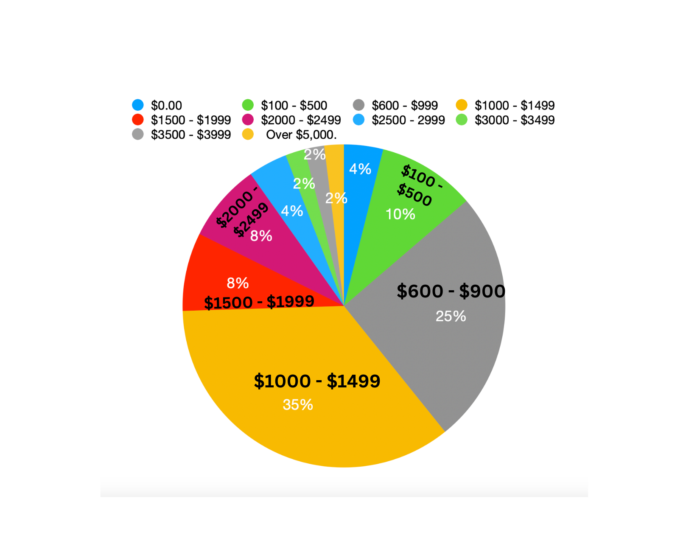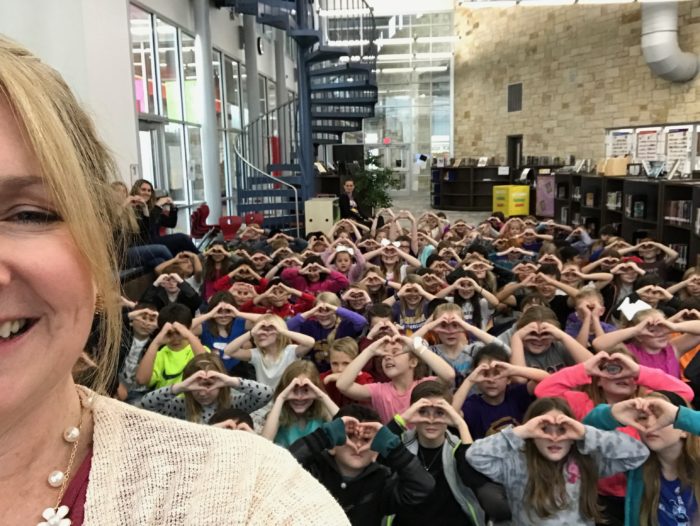
Last fall (2023), in preparation for a conference presentation I was to give about the ins and outs of school visits, I made a late decision to gather concrete data that I could work into my content. I’m a sucker for information backed up by statistics, and I always strive to provide more than expected. My survey problems began with my own itch to drill down to the sticky hot center of the author survivability issue, especially in kid lit. I suspected that a study of authors who provide school author visits would reveal much more than financial realities. In that, I was right.
In retrospect, the Google survey that I crafted indeed went beyond nuts and bolts questions but not deep enough into context to provide a complete picture. That’s what happens when an initial “simple” survey morphs with a smattering of peripheral questions. I sent my late-idea survey to a couple of author-specific Facebook groups (problem #1), and almost seventy authors from around the country responded. I am grateful for each of them. Though the results will be interesting, even revealing for many readers, I am unsatisfied because of my own shortcomings as the surveyor. So much so, I hesitated to share the findings here because: (1) The number of respondents was relatively small; (2) Outreach was limited to niche Facebook groups, so swaths of authors are not represented; (3) I omitted subquestions that are vital for full context; (4) I did not distinguish authors from author-illustrators; and (5) I omitted self-published authors because their work differs from traditionally-published authors in distinct ways, including financial structures (a dedicated survey is needed). But there are some nuggets of insight worth sharing.
Though the survey itself is imperfect, below are the results, along with comments about flaws in my approach. A fuller, more thoughtful study would be worthwhile, in my opinion. In the meantime, I hope you find the stats thought provoking.
*Note that some questions were allowed zero to multiple responses, so percentages may not equal 100%. Also, some results are represented without graphics because of graphs that don’t copy well.
First, the basics
Q: Have you seen a change in school visit requests since the pandemic?

SURVEY FLAW: Respondents were not asked about non-pandemic conditions that might have contributed to changes in their author visit requests. Ie: new books or awards, or a change in public platform
Q: Who books and manages your school visits:

Q: Of your books, which format and genre generates the most interest in your school visits?
62.7% — picture books
32.8% — middle grade
4.5% — YA
Genre
31.3% — Fiction
28.4% — Nonfiction
1.5% — Equally for early readers, graphic novels, STEAm themes, chapter books
? — Not all respondents answered this question
Q: How many traditionally published books have you authored?

SURVEY FLAW: This question was not tied to the later question about honorariums as relates to number of books published. Also not tied to the later question about whether school visit income is vital to the author’s livelihood.
Q: Which school level do you most often receive invitations from?

Q: Average number of school visits per school year
39%—6-10 schools
25%—1-5 schools
11%—11-15 schools
11%—16-20 schools
2%—21-25 schools
2%—26-30 schools
2%—31-40 schools
1%—41-50 schools
1%—50+ schools
SURVEY FLAWS:
(a) Question was open-ended.
(b) Authors, especially full-time employees or those working school visits full time are likely not on social media where this survey was shared.
(c) Subquestions about circumstances, such as awards and nominations that might temporarily increase school visit requests, were not provided.
Q: Would you prefer to book more or less school visits than your current average?
64%—Decrease
20%—Increase
12%—Remain as is
COMMENTARY: Note the similarities between the desire to decrease school visits and the later question about how vital school visit income is to the authors’ livelilhood.
Q: What type of outreach have you found most successful for securing school visits? (Reworded from original)
52% — Networking at conferences and library events
29% — Emails to individual librarians or school contacts
28% — Referrals from other authors
29% — Other
11% — Snail mail postcards or flyers
SURVEY FLAW: Respondents were able to choose more than one category
Q: How many school visit presentation options do you offer?

Who are the author respondents?
Q: Your employment status

56% — Full-time writer – no outside job
8% — Full-time writer – with a part-time outside job
8% — Full time outside job – I write when I can
3% — Part-time writer – no outside job
18% — Part-time writer – with a part-time outside job
Q: How vital is school visit income to your livelihood?

Commentary: The vast majority of traditionally-published respondents who offer school visits do not need the income as part of their livelihood. Another source of income is supporting them. This could be a day job, retirement income, freelancing, a trust fund, a partner, a benefactor, etc.
* Question to ponder: Does consistently providing professional-level speaking services for no or drastically-discounted rates qualify as philanthropy, donations, hobby?
SURVEY FLAW #1: As mentioned earlier, the limited outreach and small scope of this survey eliminates far too many voices.
SURVEY FLAW #2: The survey question did not connect the level of each traditionally-published respondent’s honorarium with their dependence on school visit income as a livelihood. It is a logical assumption that the respondent’s charging the least amount for school visits either represent the financial averages for their specific region, or they are not reliant on the income for their livelihood and have the luxury of not charging market rate.
Q: How much is your average honorarium for a full-day school visit (~3 presentations), not including travel expenses?

* Unfortunately, authors who consistently undercharge, or perform free of charge, risk setting a precedence — an expectation among many school communities. When any privileged subset of a community sets a financial precedent, it creates negative repercussions for less-privileged counterparts and those pursuing the endeavor as a viable career. This represents a small part of larger inequity concerns.
BIG OLE SURVEY FLAWS: (1) The survey question did not differentiate local author visits versus those that require travel, and (2) The survey question did not ask for qualifying information such as the respondent’s region, number of traditionally published books, book awards, high-profile platforms, etc. All of those factors affect honorariums, so these current numbers should be taken with a grain of salt.
Q: Have you been uninvited from school visits for any of the following reasons?
Have the respondents been uninvited, or passed over by schools (if known), because of their race or sexual orientation or the race, sexual orientation, or ethnic identity of their books’ characters?
5% — responded YES
One author responded YES – They were uninvited to school visits because they identify as LGBTQ+
Three responded YES – They were uninvited because their book(s) contain at least one character who identifies as LGBTQ+
One responded YES – They were uninvited because of the Jewish themes in their book
One responded YES – Their picture book was deemed too political
Conclusion:
The school visit world is complex and involves politics, budgets, personalities. Still, they are fantastic for students because authors are uniquely qualified to model a love of reading and writing while supporting classroom curriculum. And the opportunities are great for authors because they are able to engage with their young readers, promote their books, and supplement—if not entirely provide—their household income. Making a living as an author is almost impossible without another income source, and school visits are one source that makes it possible for some authors to continue with their creative endeavors. The reality is that many authors, especially kidlit authors, are in privileged positions—financially or otherwise— that afford them choice and security. According to this survey, the vast majority of respondents fall into this category. It sparks even more questions, doesn’t it? How many schools prioritize price when they choose a visiting author? Are full-time authors leaving school visits to seek more reliable income? Do authors who offer school visits at nominal or zero honorarium negatively affect authors who rely on the income? What conclusions can be drawn from this data about how authors view school visits as professional services? How might the current trend effect the support of equity and diverse representations?
The conversation is long overdue. Let’s start talking.
Donna Janell Bowman is the award-winning author of many books for young readers, and she is a popular speaker at schools around the country. Her next book, WINGS OF AN EAGLE: THE GOLD MEDAL DREAMS OF BILLY MILLS, co-authored with Billy Mills (Oglala Lakota), and illustrated by S.D. Nelson (Lakota) publishes July 2, 2024.



Thank you!
I definitely require support from another income, but my goal is to make a living from writing and related work. School visits absolutely play into that so my fees reflect that.
I hear your apologies—many flaws await when surveys are done. But I think you gathered some important information that we can learn from. Thanks for your efforts!